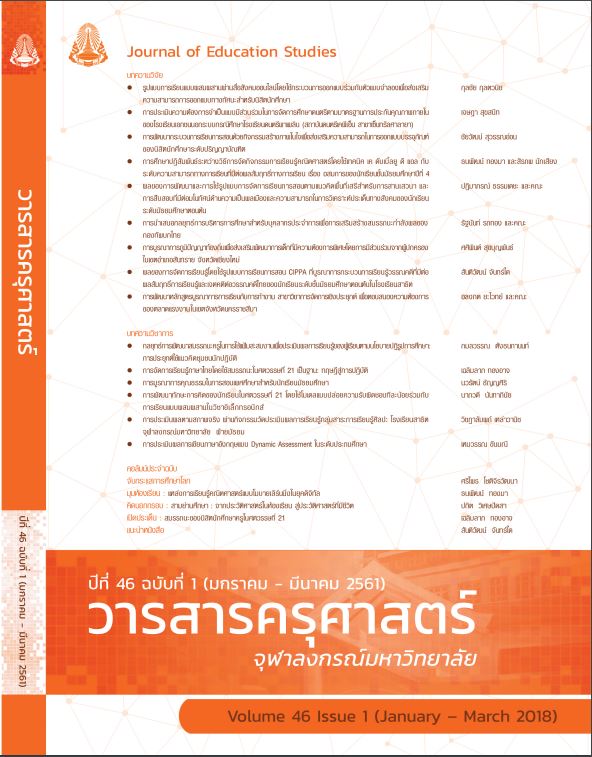การศึกษาปฏิสัมพันธ์ระหว่างวิธีการจัดกิจกรรมการเรียนรู้คณิตศาสตร์โดยใช้เทคนิค เค ดับเบิ้ลยู ดี แอล กับระดับความสามารถทางการเรียนที่มีต่อผลสัมฤทธิ์ทางการเรียนเรื่องอสมการ ของนักเรียนชั้นมัธยมศึกษาปีที่ 4
คำสำคัญ:
เทคนิค เค ดับเบิ้ลยู ดี แอล, อสมการ, การวิเคราะห์ความแปรปรวนสองทาง, K-W-D-L TECHNIQUES, INEQUALITY, TWO-WAY ANOVAบทคัดย่อ
การวิจัยในครั้งนี้มีวัตถุประสงค์ 2 ประการ คือ (1) เพื่อเปรียบเทียบผลสัมฤทธิ์ทางการเรียนเรื่องอสมการของนักเรียนชั้นมัธยมศึกษาปีที่ 4 ระหว่างกลุ่มที่เรียนโดยใช้เทคนิค เค ดับเบิ้ลยู ดี แอล กับกลุ่มที่เรียนแบบปกติ และ (2) เพื่อศึกษาปฏิสัมพันธ์ระหว่างวิธีการจัดกิจกรรมการเรียนรู้คณิตศาสตร์โดยใช้เทคนิค เค ดับเบิ้ลยู ดี แอล กับระดับความสามารถทางการเรียนที่มีต่อผลสัมฤทธิ์ทางการเรียนเรื่องอสมการของนักเรียนชั้นมัธยมศึกษาปีที่ 4 กลุ่มตัวอย่างที่ใช้ในการวิจัยครั้งนี้ได้มาจากการเลือกแบบเจาะจง คือ นักเรียนชั้นมัธยมศึกษาปีที่ 4/1 และ 4/2 ภาคเรียนที่ 1
ปีการศึกษา 2560 โรงเรียนสาธิตจุฬาลงกรณ์มหาวิทยาลัย ฝ่ายมัธยม โดยให้นักเรียนชั้นมัธยมศึกษาปีที่ 4/1 จำนวน 33 คน เป็นนักเรียนกลุ่มทดลองซึ่งได้รับการจัดกิจกรรมการเรียนรู้คณิตศาสตร์โดยใช้เทคนิค เค ดับเบิ้ลยู ดี แอล และนักเรียนชั้นมัธยมศึกษาปีที่ 4/2 จำนวน 31 คน เป็นนักเรียนกลุ่มควบคุมซึ่งได้รับการจัดกิจกรรมการเรียนรู้คณิตศาสตร์แบบปกติ เครื่องมือที่ใช้ในการเก็บรวบรวมข้อมูลคือ แบบทดสอบวัดผลสัมฤทธิ์ทางการเรียนเรื่องอสมการ โดยมีค่าความเที่ยงของแบบทดสอบทั้งฉบับเท่ากับ 0.863 เครื่องมือที่ใช้ในการทดลองคือ แผนการจัดการเรียนรู้โดยใช้เทคนิค เค ดับเบิ้ลยู ดี แอล และแผนการจัดการเรียนรู้แบบปกติ วิเคราะห์ข้อมูลโดยใช้ค่าเฉลี่ยเลขคณิต ส่วนเบี่ยงเบนมาตรฐาน ร้อยละ การทดสอบทีสำหรับกลุ่มตัวอย่างสองกลุ่มที่เป็นอิสระต่อกัน (Independent Samples t-test) และการวิเคราะห์ความแปรปรวนสองทาง (Two–way ANOVA)
ผลการวิจัยพบว่า 1) นักเรียนชั้นมัธยมศึกษาปีที่ 4 กลุ่มที่ได้รับการจัดการเรียนรู้คณิตศาสตร์โดยใช้เทคนิค
เค ดับเบิ้ลยู ดี แอล มีผลสัมฤทธิ์ทางการเรียนเรื่องอสมการไม่แตกต่างจากกลุ่มที่ได้รับการจัดกิจกรรมการเรียนรู้คณิตศาสตร์แบบปกติอย่างมีนัยสำคัญทางสถิติที่ระดับ .05 และ 2) วิธีการจัดกิจกรรมการเรียนรู้คณิตศาสตร์กับระดับความสามารถทางการเรียนของนักเรียนมีปฏิสัมพันธ์ร่วมกันส่งผลต่อผลสัมฤทธิ์ทางการเรียนเรื่องอสมการอย่างมีนัยสำคัญทางสถิติที่ระดับ .01 โดยนักเรียนกลุ่มเก่งและกลุ่มปานกลาง วิธีการจัดกิจกรรมการเรียนรู้คณิตศาสตร์จะไม่ส่งผลต่อผลสัมฤทธิ์ทางการเรียนเรื่องอสมการอย่างมีนัยสำคัญทางสถิติที่ระดับ .05 แต่สำหรับนักเรียนกลุ่มอ่อน วิธีการจัดกิจกรรมการเรียนรู้คณิตศาสตร์จะส่งผลต่อผลสัมฤทธิ์ทางการเรียนเรื่องอสมการอย่างมีนัยสำคัญทางสถิติที่ระดับ .05 โดยนักเรียนกลุ่มที่เรียนโดยใช้เทคนิค เค ดับเบิ้ลยู ดี แอล จะมีผลสัมฤทธิ์ทางการเรียนเรื่องอสมการสูงกว่ากลุ่มที่เรียนแบบปกติ
The purposes of this research were (1) to compare mathematics learning achievement on inequality of tenth grade students between groups being taught by using K-W-D-L techniques and by using conventional approach and (2) to study of the interaction between using K-W-D-L techniques and learning ability with mathematics learning achievement on inequality of tenth grade students. The sample was selected by using purposive sampling included Mathayom 4/1 and Mathayom 4/2 students of Chulalongkorn University Demonstration Secondary School in the first semester of academic year 2017. The experimental group with 33 students of Mathayom 4/1 were organized mathematics learning activities by using K-W-D-L techniques and the controlled group with 31 students of Mathayom 4/2 were organized mathematics learning activities by conventional approach. The data collection instrument was the mathematics learning achievement test on inequality, which had the reliability of the test at 0.863. The experimental instruments constructed by the researcher were lesson plans using K-W-D-L techniques and lesson plans using conventional approach. The data were analyzed by means of arithmetic, standard deviation, percentage, independent samples t-test and two-way ANOVA.
The research results revealed as follows: 1) The mathematics learning achievement on inequality of tenth grade students being organized mathematics learning activities by using K-W-D-L techniques were not different from those of students being organized mathematics learning activities by using conventional approach at .05 level of significance and 2) Approaches of mathematics learning activities and learning ability interacted with mathematics learning achievement on inequality at .01 level of significance. The mathematics learning achievement on inequality of the students with high and moderate learning abilities taught by using K-W-D-L techniques and by using conventional approach were not different at .05 level of significance. However, the mathematics learning achievement on inequality of the students with a low learning ability taught by using K-W-D-L techniques and by using conventional approach was different at .05 level of significance that the mathematics learning achievement on inequality of the students being organized mathematics learning activities by using K-W-D-L techniques were higher than those of students being organized mathematics learning activities by using conventional approach.




